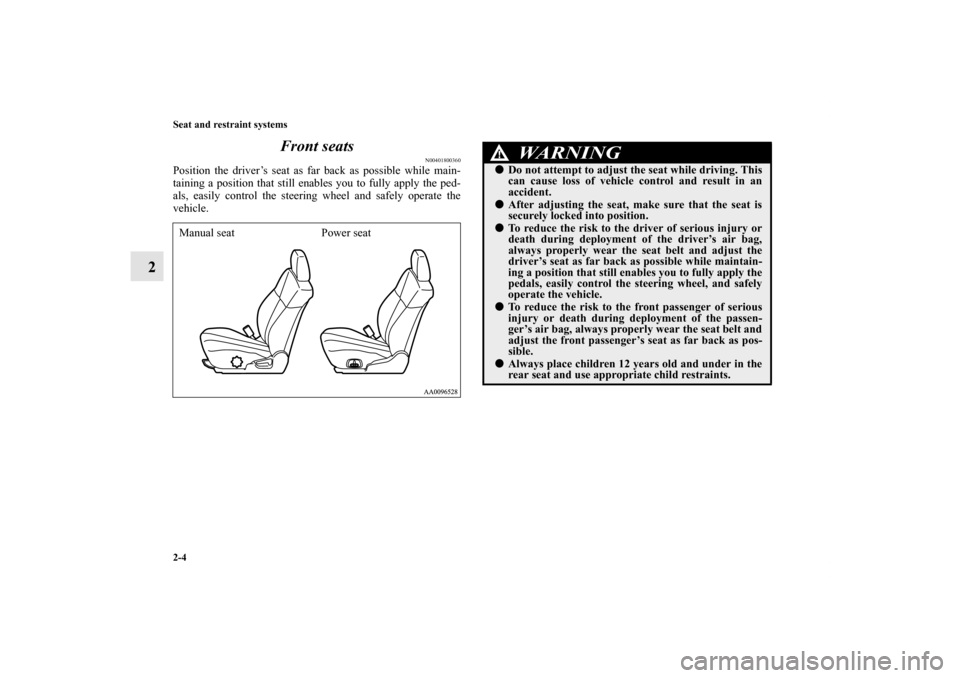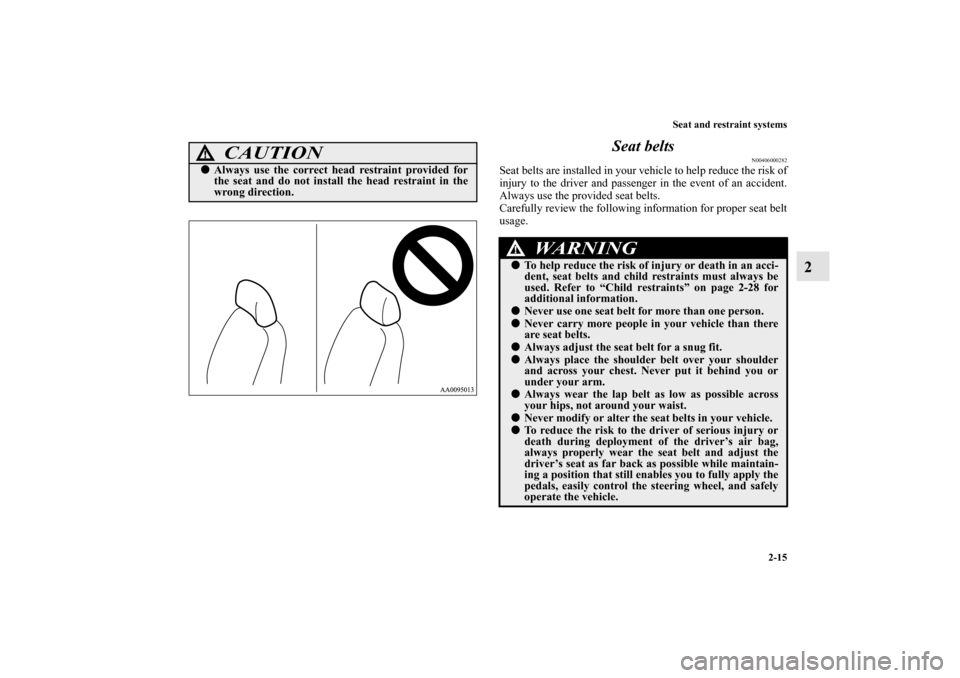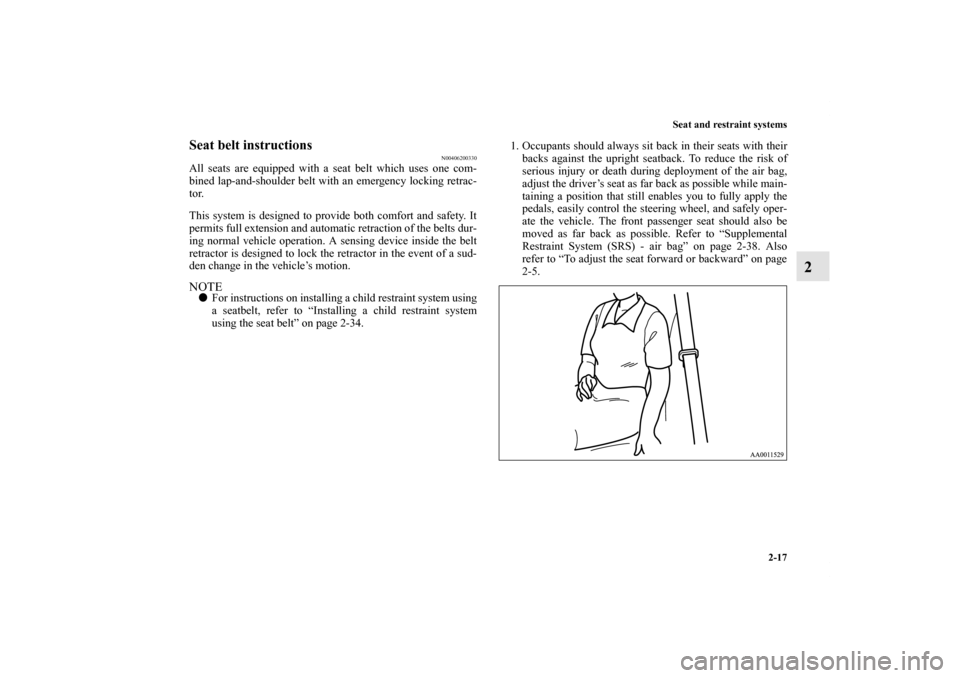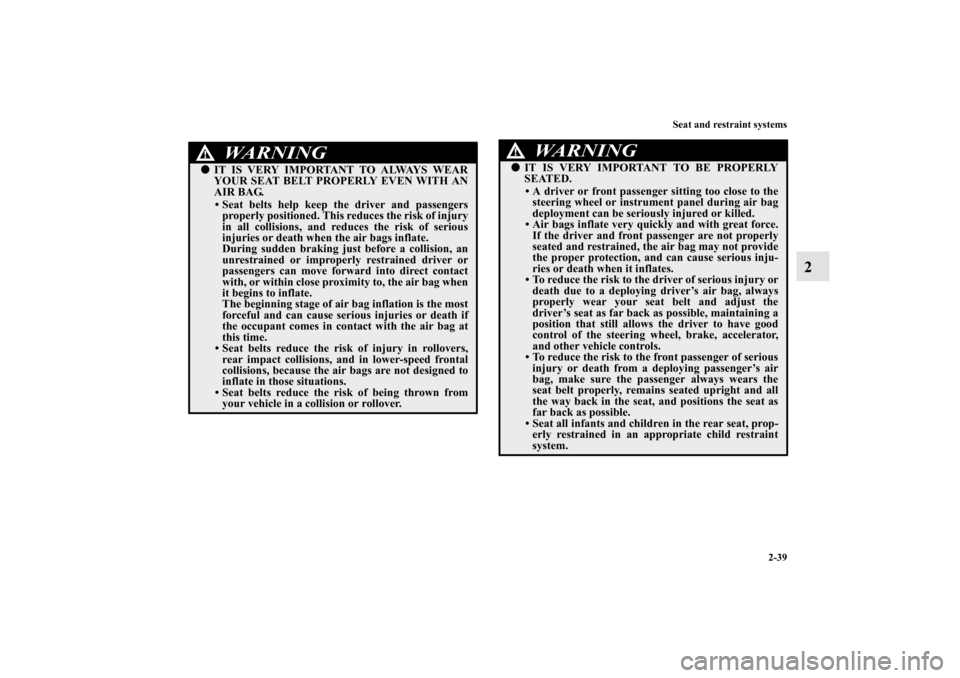Page 3 of 424
Overview
Instruments and controls
N00100201202
Combination headlights and
dimmer switch P.3-81
Turn signal lever P.3-84
Supplemental restraint
system - air bag
(for driver’s seat) P.2-38
Horn switch P.3-91
Instrument panel light dimmer control knob P.3-87
Fog light switch
(if so equipped)
P. 3 - 8 6Steering wheel remote
control switch
(if so equipped) P.5-62 Instrument cluster
P. 3 - 7 2
Cruise control lever
P. 3 - 5 7 Ignition switch P.3-34 Wiper and washer
switch P.3-87
Fuses P.7-35
Active stability control (ASC)
OFF switch P.3-53 Engine hood release lever
P. 7 - 4Steering wheel tilt lock
lever P.3-29
BK0121200US.book 1 ページ 2010年4月14日 水曜日 午前11時24分
Page 15 of 424
6 Quick index
If this problem occurs...
N00200900694
Problem
Do this
Ref. Page
Cannot turn the key.
From “LOCK” to “ACC”
Turn the key while jogging the steering wheel in either direction.
From “ACC” to “LOCK”
Check the position of the selector lever.
The key cannot be removed unless the selector lever is set to the “P” (PARK) position.P.3-34,
3-36
Cannot shift the selector lever
from the “P” (PARK) position.Shift the selector lever while pressing the brake pedal.
Check that the ignition key is in the “ON” position.P.3-39
The windows are fogged up.
1. Set the mode selection dial to the “ ” or “ ” position.
2. Turn on the blower.P.5-12,
5-19
The engine does not start.
The lights do not come on.
The lights are dim.
The horn does not honk.
The horn sound is weak.Have the battery checked. Recharge or replace as needed.P. 6 - 2 ,
7-15BK0121200US.book 6 ページ 2010年4月14日 水曜日 午前11時24分
Page 31 of 424

2-4 Seat and restraint systems
2Front seats
N00401800360
Position the driver’s seat as far back as possible while main-
taining a position that still enables you to fully apply the ped-
als, easily control the steering wheel and safely operate the
vehicle.
Power seat Manual seat
WA R N I N G
!�Do not attempt to adjust the seat while driving. This
can cause loss of vehicle control and result in an
accident. �After adjusting the seat, make sure that the seat is
securely locked into position.�To reduce the risk to the driver of serious injury or
death during deployment of the driver’s air bag,
always properly wear the seat belt and adjust the
driver’s seat as far back as possible while maintain-
ing a position that still enables you to fully apply the
pedals, easily control the steering wheel, and safely
operate the vehicle.�To reduce the risk to the front passenger of serious
injury or death during deployment of the passen-
ger’s air bag, always properly wear the seat belt and
adjust the front passenger’s seat as far back as pos-
sible. �Always place children 12 years old and under in the
rear seat and use appropriate child restraints.
BK0121200US.book 4 ページ 2010年4月14日 水曜日 午前11時24分
Page 42 of 424

Seat and restraint systems
2-15
2 Seat belts
N00406000282
Seat belts are installed in your vehicle to help reduce the risk of
injury to the driver and passenger in the event of an accident.
Always use the provided seat belts.
Carefully review the following information for proper seat belt
usage.
CAUTION
!�Always use the correct head restraint provided for
the seat and do not install the head restraint in the
wrong direction.
WA R N I N G
!�To help reduce the risk of injury or death in an acci-
dent, seat belts and child restraints must always be
used. Refer to “Child restraints” on page 2-28 for
additional information.�Never use one seat belt for more than one person. �Never carry more people in your vehicle than there
are seat belts. �Always adjust the seat belt for a snug fit.�Always place the shoulder belt over your shoulder
and across your chest. Never put it behind you or
under your arm. �Always wear the lap belt as low as possible across
your hips, not around your waist.�Never modify or alter the seat belts in your vehicle.�To reduce the risk to the driver of serious injury or
death during deployment of the driver’s air bag,
always properly wear the seat belt and adjust the
driver’s seat as far back as possible while maintain-
ing a position that still enables you to fully apply the
pedals, easily control the steering wheel, and safely
operate the vehicle.
BK0121200US.book 15 ページ 2010年4月14日 水曜日 午前11時24分
Page 44 of 424

Seat and restraint systems
2-17
2
Seat belt instructions
N00406200330
All seats are equipped with a seat belt which uses one com-
bined lap-and-shoulder belt with an emergency locking retrac-
tor.
This system is designed to provide both comfort and safety. It
permits full extension and automatic retraction of the belts dur-
ing normal vehicle operation. A sensing device inside the belt
retractor is designed to lock the retractor in the event of a sud-
den change in the vehicle’s motion. NOTE�For instructions on installing a child restraint system using
a seatbelt, refer to “Installing a child restraint system
using the seat belt” on page 2-34.1. Occupants should always sit back in their seats with their
backs against the upright seatback. To reduce the risk of
serious injury or death during deployment of the air bag,
adjust the driver’s seat as far back as possible while main-
taining a position that still enables you to fully apply the
pedals, easily control the steering wheel, and safely oper-
ate the vehicle. The front passenger seat should also be
moved as far back as possible. Refer to “Supplemental
Restraint System (SRS) - air bag” on page 2-38. Also
refer to “To adjust the seat forward or backward” on page
2-5.
BK0121200US.book 17 ページ 2010年4月14日 水曜日 午前11時24分
Page 66 of 424

Seat and restraint systems
2-39
2
WA R N I N G
!�IT IS VERY IMPORTANT TO ALWAYS WEAR
YOUR SEAT BELT PROPERLY EVEN WITH AN
AIR BAG.
• Seat belts help keep the driver and passengers
properly positioned. This reduces the risk of injury
in all collisions, and reduces the risk of serious
injuries or death when the air bags inflate.
During sudden braking just before a collision, an
unrestrained or improperly restrained driver or
passengers can move forward into direct contact
with, or within close proximity to, the air bag when
it begins to inflate.
The beginning stage of air bag inflation is the most
forceful and can cause serious injuries or death if
the occupant comes in contact with the air bag at
this time.
• Seat belts reduce the risk of injury in rollovers,
rear impact collisions, and in lower-speed frontal
collisions, because the air bags are not designed to
inflate in those situations.
• Seat belts reduce the risk of being thrown from
your vehicle in a collision or rollover.
�IT IS VERY IMPORTANT TO BE PROPERLY
SEATED.
• A driver or front passenger sitting too close to the
steering wheel or instrument panel during air bag
deployment can be seriously injured or killed.
• Air bags inflate very quickly and with great force.
If the driver and front passenger are not properly
seated and restrained, the air bag may not provide
the proper protection, and can cause serious inju-
ries or death when it inflates.
• To reduce the risk to the driver of serious injury or
death due to a deploying driver’s air bag, always
properly wear your seat belt and adjust the
driver’s seat as far back as possible, maintaining a
position that still allows the driver to have good
control of the steering wheel, brake, accelerator,
and other vehicle controls.
• To reduce the risk to the front passenger of serious
injury or death from a deploying passenger’s air
bag, make sure the passenger always wears the
seat belt properly, remains seated upright and all
the way back in the seat, and positions the seat as
far back as possible.
• Seat all infants and children in the rear seat, prop-
erly restrained in an appropriate child restraint
system. WA R N I N G
!
BK0121200US.book 39 ページ 2010年4月14日 水曜日 午前11時24分
Page 67 of 424
2-40 Seat and restraint systems
2
WA R N I N G
!�Air bags inflate very quickly and with great force.
Do not sit on the edge of the seat or lean your head
or chest close to the steering wheel or the instrument
panel.�Do not put your feet or legs on or against the instru-
ment panel.
WA R N I N G
!�Infants and small children should never ride unre-
strained, or lean against the instrument panel. They
should never ride held in your arms or on your lap.
They can be seriously injured or killed in an acci-
dent, especially when the air bags inflate. Infants
and children should be properly seated in the rear
seat in an appropriate child restraint system. Refer
to “Child restraints” on page 2-28.
BK0121200US.book 40 ページ 2010年4月14日 水曜日 午前11時24分
Page 75 of 424
2-48 Seat and restraint systems
2
Driver’s and passenger’s front air bag system
N00407900204
The driver’s air bag is located under the padded cover in the
middle of the steering wheel. The front passenger’s air bag is
contained in the instrument panel above the glove compart-
ment. The driver’s air bag and the front passenger’s air bag are
designed to deploy at the same time. However, the front pas-
senger’s air bag does not deploy when the front passenger seat
is not occupied or when the weight sensor in the front passen-
ger seat senses a weight on the seat of less than approximately
66 pounds (30 kg).
Driver
Front passenger
BK0121200US.book 48 ページ 2010年4月14日 水曜日 午前11時24分